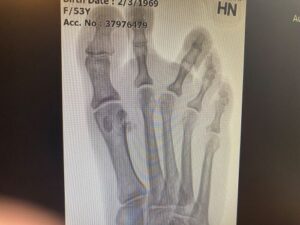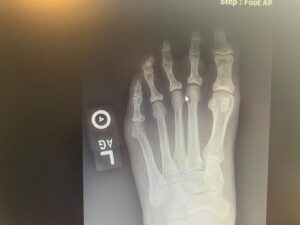![]()
Same Day Appointments Available!
Call Us 24/7 (801) 619-2170
Salt Lake City * Sandy * West Jordan

Causes & Treatments of Toe Separation
Home » Blog » Causes & Treatments of Toe Separation
Toe separation is a common occurrence that usually involves the second and third toes. It has many different causes, though the most common are neuromas, plantar plate tears, ligament ruptures, and Morton foot type.

Patients usually seek a healthcare provider for toe separation cases when the condition becomes painful, worsens, or is unaesthetic enough for the patient to warrant action.
Neuromas
The plantar nerves stretch along the sole of the foot, branching and providing sensation to different areas. A Morton’s neuroma is a growth on (or inflammation of) the nerves, typically between the metatarsal bones.
This increased mass in between the metatarsal heads leads to increased space between each toe.
Neuromas exhibit symptoms such as pain, pins and needles, the feeling of a sockballed up under the toes, and numbness. If the inflammation persists, the nerve becomes fibrous and hardens, and the area becomes increasingly painful and palpable.
Treatment involves a change in shoe gear, arch supports, ice, and cortisone injections to reduce nerve inflammation. Excisions of neuromas can also be performed; however, the toes may or may not come together even after treatment.
The longer the neuroma is present, the more likely the toes will remain separated because certain ligaments have become stretched out, and others become tight. Further surgery where the tight ligament is released, in addition to a capsulotomy is performed, will bring the digits together.
Plantar Plates
The plantar plate is a thickening of tissue at the plantar aspect of metatarsal heads. The plate is an extension of the plantar fascial band that enters the forefoot and divides into four slips of fascial tissue.
The plantar plate can become sprained or torn from trauma. When this happens, the metatarsophalangeal joint becomes unstable, causing the digits to separate.
The pain usually presents on the bottom of the digit and is a sharp, aching pain. Unfortunately, the majority of plantar plate injuries require surgery to heal properly.
Pain symptoms themselves are treated with ice and anti-inflammatories, splinting the toe in the down position, and wearing a stiff-soled shoe.
Ligament Ruptures
There are two ligaments that attach the toe to the metatarsal head. They are both medial and lateral to the metatarsophalangeal joint. Any trauma that causes the ligament to rupture will make the toes separate.
Common sources of trauma that lead to separation include the catching of the toe on something that pulls it sideways and the overutilization of cortisone injections.
Cortisone is an anti-inflammatory that is injected into the area of pain, which also has a secondary effect of breaking down soft tissue.
Trained podiatrists will typically do one cortisone injection – in the interspace for a neuroma, for example – and no more. Any more than one injection can cause ligament rupture in the interspace, thus making the toes separate.
Other areas of the body may be treated differently with cortisone injections, with one example being the plantar fascial band when treating plantar fasciitis, which can be injected multiple times over a period of 6 months.
Surgery is required to repair the ruptured ligament itself. Symptoms may be treated with ice, anti-inflammatories, a stiff-soled shoe, and toe separators.
Morton’s Foot Type
A Morton’s foot type, or Morton’s toe, is when the second digit is longer than the first.
Physiologically, the first metatarsal in Morton’s foot type is over two millimeters shorter than the second metatarsal. When this occurs, the second metatarsal does the majority of work during ambulation as opposed to the first.
Over time, capsulitis of the second metatarsophalangeal joint and over-stretching of the medial and lateral ligaments happen, and partial to full plantar plate tear may occur. Toe separators, custom orthotics, and ice may reduce symptoms of pain, though they will not permanently correct the toe separation.
Surgery involves shortening the long metatarsal, along with ligament repair, so the first metatarsophalangeal joint does the majority of the work. A custom orthotic is also worn after a full recovery from surgery.
The X-rays represent two of my patients with toe separation. In both, the second metatarsal is over two millimeters longer than the first (in one of the x-rays, the third metatarsal is also long), and a neuroma was present in the 2nd intermetatarsal space.
Both patients had the long metatarsal shortened and the neuroma removed.
Treat Toe Separation With the Help of an Expert Podiatrist
When your toe separation causes you discomfort or pain, contact Salt Lake City Podiatrist Dr. Elizabeth Auger, DPM. She has worked for over twenty-four years in the industry as a podiatrist, delivering relief, comfort, and healing to patients of all backgrounds.
Dr. Auger offers same-day appointments for whatever ailment your feet might face. You can reach her online or by calling 801-619-2170.
Foot and Ankle
Conditions
- Allergic Contact Dermititis
- Achilles Tendonitis
- Athlete’s Foot
- Brachymetatarsia
- Bunions
- Calluses
- Diabetes
- Flatfoot (Fallen Arches)
- Foot Ulcerations (Diabetic Ulcers/Wounds)
- Salt Lake City Fungal Nail
- Ganglions
- Gout
- Haglund’s Deformity
- Hallux Rigidus
- Hammertoes
- Heel Pain (Fasciitis)
- Foot Infections
- Ingrown Toenails
- Injuries
- Metatarsalgia
- Morton’s Neuroma
- Osteoarthritis
- Paronychia
- Plantar Fasciitis
- Plantar Warts
- Posterior Tibial Dysfunction
- Rheumatoid Arthritis
- Running Injuries
- Sesamoiditis
- Skin Conditions
- Sprains & Strains
- Tailor’s Bunion
- Tarsal Tunnel Syndrome
- Tendonitis
- Toe Deformities
- Xerosis
1561 W 7000 S, Suite 200
West Jordan, Utah 84084
(801) 509-9959
3934 S 2300 E
Salt Lake City, UT 84124
(801) 396-9743

